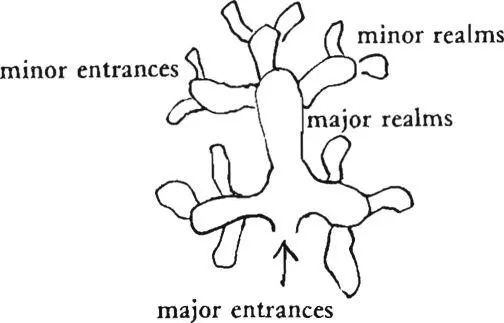Christopher alexander - A pattern language
Здесь есть возможность читать онлайн «Christopher alexander - A pattern language» весь текст электронной книги совершенно бесплатно (целиком полную версию без сокращений). В некоторых случаях можно слушать аудио, скачать через торрент в формате fb2 и присутствует краткое содержание. Жанр: Прочая научная литература, на английском языке. Описание произведения, (предисловие) а так же отзывы посетителей доступны на портале библиотеки ЛибКат.
- Название:A pattern language
- Автор:
- Жанр:
- Год:неизвестен
- ISBN:нет данных
- Рейтинг книги:3 / 5. Голосов: 1
-
Избранное:Добавить в избранное
- Отзывы:
-
Ваша оценка:
- 60
- 1
- 2
- 3
- 4
- 5
A pattern language: краткое содержание, описание и аннотация
Предлагаем к чтению аннотацию, описание, краткое содержание или предисловие (зависит от того, что написал сам автор книги «A pattern language»). Если вы не нашли необходимую информацию о книге — напишите в комментариях, мы постараемся отыскать её.
A pattern language — читать онлайн бесплатно полную книгу (весь текст) целиком
Ниже представлен текст книги, разбитый по страницам. Система сохранения места последней прочитанной страницы, позволяет с удобством читать онлайн бесплатно книгу «A pattern language», без необходимости каждый раз заново искать на чём Вы остановились. Поставьте закладку, и сможете в любой момент перейти на страницу, на которой закончили чтение.
Интервал:
Закладка:
i
'“I \Jnscf
cjxxjt
The way the map in your mind, works.
482 98 CIRCULATION REALMS
A map works because it identifies a nested system of realms (in the case of our example the realms arc first, the building itself, then the courtyard, then the arcade, then the room itself, the destination). The map guides you to the entrance of the largest realm, and from there to the entrance of the next largest realm, and so on. You make one decision at a time, and each decision you make narrows down the extent of the building which remains to be explored, until you finally narrow it down to the particular address you are looking for.
It seems reasonable to say that any useful map through a building complex must have this structure, and that any building complex in which you cannot create maps of this kind is confusing to be in. This is borne out by intuition. Consider these two examples; each has a system of realms which allows you to make such maps very easily.
An Oxford college. Here the college is made up of courts, each court has a collection of rooms called a “staircase” opening off it, and the individual suites of rooms open off these staircases. The realms are; College, Courts, Staircases, Rooms.
Manhattan. Here the city is made up of major areas, each major area has certain central streets and arteries. The realms are: Manhattan, Districts, Realms defined by the avenues, and Realms defined by cross streets and individual buildings. Manhattan is clear because the districts are so well defined, and the realms defined by the streets are subordinate to the realms defined by the avenues.
We conclude that in order to be clear, a building complex must follow three rules:
1. It is possible to identify a nested system of realms in the complex, the first and largest of these realms being the entire complex.
2. Each realm has a main circulation space, which opens directly from the entrances to that realm.
3. The entrances to any realm open directly off the circulation space of the next larger realm above it.
We emphasize finally, that these realms at every level must have names- and this requires, in turn, that they be well enough defined physically, so that they can in fact be named, and so that one knows where the realm of that name starts, and where it
stops. The realms do not have to be as precise as in the two examples we have given. But they must have enough psychological substance and existence so that they can honestly work as realms in somebody’s mind.
Therefore:

Lay out very large buildings and collections of small buildings so that one reaches a given point inside by passing through a sequence of realms, each marked by a gateway and becoming smaller and smaller, as one passes from each one, through a gateway, to the next. Choose the realms so that each one can be easily named, so that you can tell a person where to go, simply by telling him which realms to go through.
Treat the first entrances to the whole system of circulation realms, the very largest ones, as gateways— main gateways (53)■, make the major realms, which open off the gateways, pedestrian streets or common land— common eand(67), pedestrian street(100) ; then, make minor realms with individual buildings, and courtyards, and major indoor streets— main building
(99), BUILDING THOROUGHFARE (iOl), HIERARCHY OF OPEN
space(i 14) , courtyards which live(I I 5) ; and mark the entrance to these minor realms with minor entrances that still stand out quite clearly— family of entrances(102), main entrance(1 10). Make the layout of paths consonant with paths and goals(1 20)....
| 99 main building* |
|---|
 |
485
Do what you can to establish a world government ywith a thousand independent regions , instead of countries;
I. INDEPENDENT REGIONS
. . . once you have decided more or ]ess how people will move around within the building complex(95), and roughly how high the buildings will be—number of stories(96) —it is time to try and find the natural heart or center of the building complex, to help complete its circulation realms(98).
A complex of buildings with no center is like a man without a head.
In circulation realms we have explained how people understand their surroundings and orient themselves in their surroundings by making mental maps. Such a map needs a point of reference: some point in the complex of buildings, which is very obvious, and so placed, that it is possible to refer all the other paths and buildings to it. A main building, which is also the functional soul of the complex, is the most likely candidate for this reference point. Without a main building, there is very little chance of any natural points of reference being strong enough to act as an organizer for one’s mental map.
Furthermore, from the point of view of the group of users—the workers or the inhabitants—the sense of community and connection is heightened when one building or a part of one building is singled out and treated as a main building, common to all, the heart of the institution. Some examples: the meeting hall among a collection of government buildings; a guild hall in a work community; the kitchen and family room in a communal household; the merry-go-round in a park; a temple on sacred ground; the swimming pavilion in a health center; the workshop in an office.
Great care must be taken to pick that function which is actually the soul of the group, in human terms, for the main building. Otherwise, some irrelevant set of functions will dominate the building complex. The United Nations complex in New York fails for just this reason. Tire General Assembly, the heart and soul of the institution, is dwarfed by the bureaucratic Secretariat. And, indeed, this institution has suffered from the
486
99 main building
red-tape mentality. (See the excellent series of articles by Lewis Mumford, discussing the U.N. buildings in From the Ground, Up, Harvest Books, 1956, pp. 20-70.)
Therefore:
For any collection of buildings, decide which building in the group houses the most essential function—which building is the soul of the group, as a human institution. Then form this building as the main building, with a central position, higher roof.
Even if the building complex is so dense that it is a single building, build the main part of it higher and more prominent than the rest, so that the eye goes immediately to the part which is the most important.
| high roof |
|---|
 |
Build all the main paths tangent to the main building, in arcades or glazed corridors, with a direct view into its main functions— common areas at the heart (129). Make the roof cascade down from the high roof over the main building to lower roofs over the smaller buildings— cascade of roofs ( i 16). And for the load bearing structure, engineering, and construction, begin with STRUCTURE FOLLOWS SOCIAL SPACES(2O5). . . .
Читать дальшеИнтервал:
Закладка:
Похожие книги на «A pattern language»
Представляем Вашему вниманию похожие книги на «A pattern language» списком для выбора. Мы отобрали схожую по названию и смыслу литературу в надежде предоставить читателям больше вариантов отыскать новые, интересные, ещё непрочитанные произведения.
Обсуждение, отзывы о книге «A pattern language» и просто собственные мнения читателей. Оставьте ваши комментарии, напишите, что Вы думаете о произведении, его смысле или главных героях. Укажите что конкретно понравилось, а что нет, и почему Вы так считаете.












